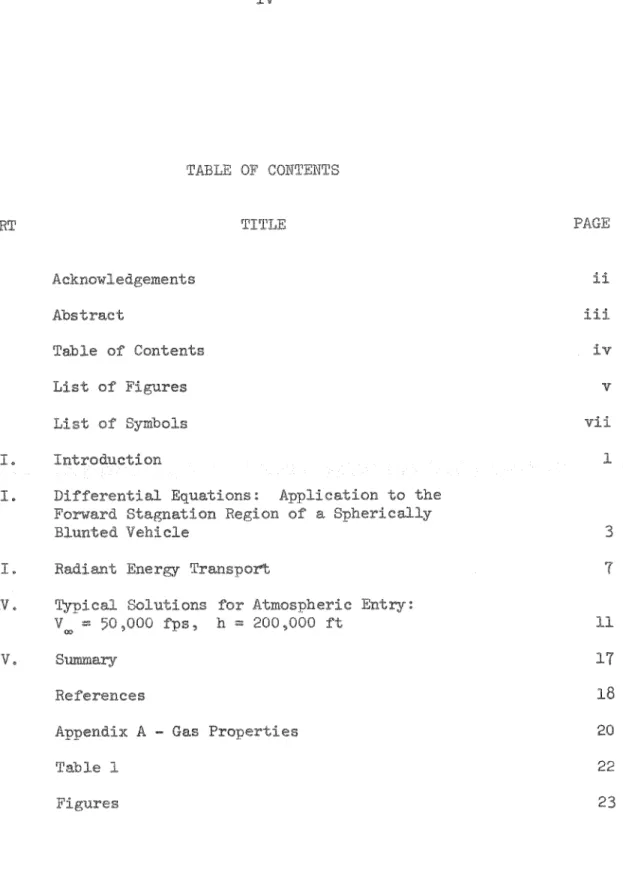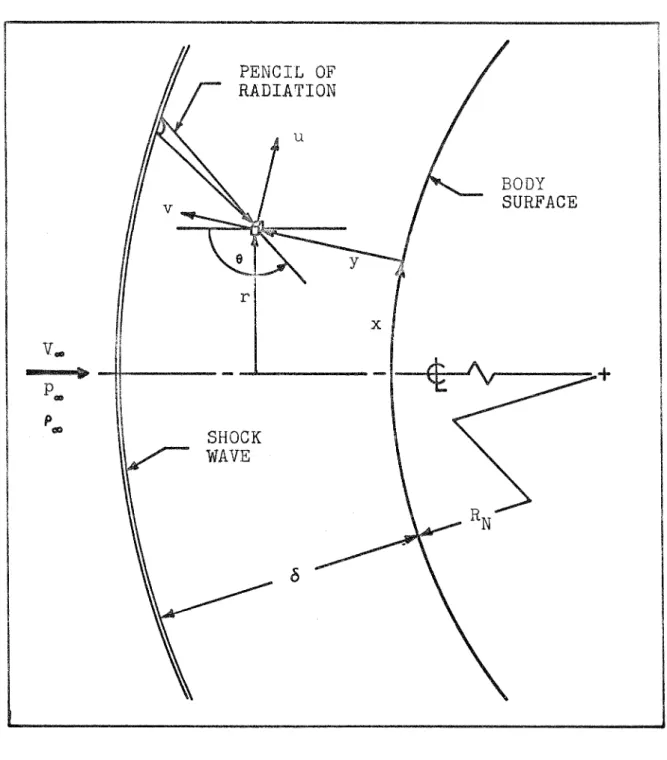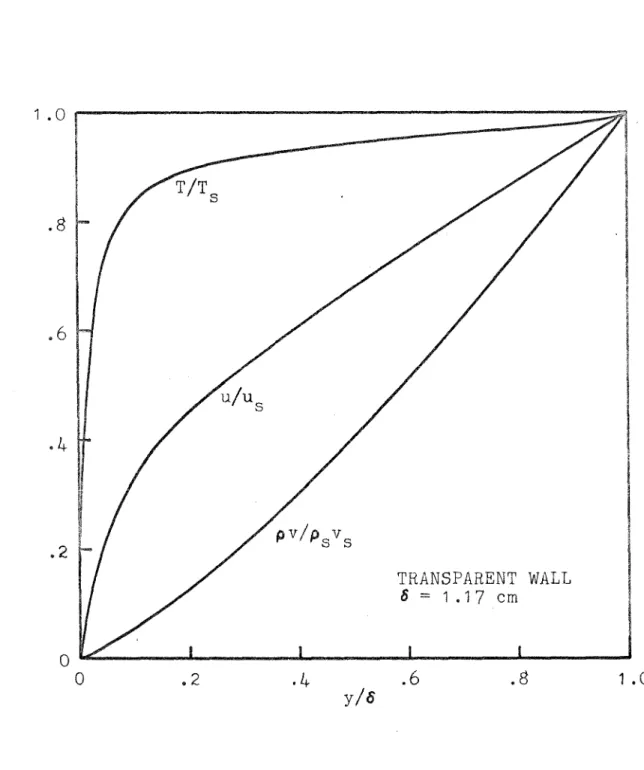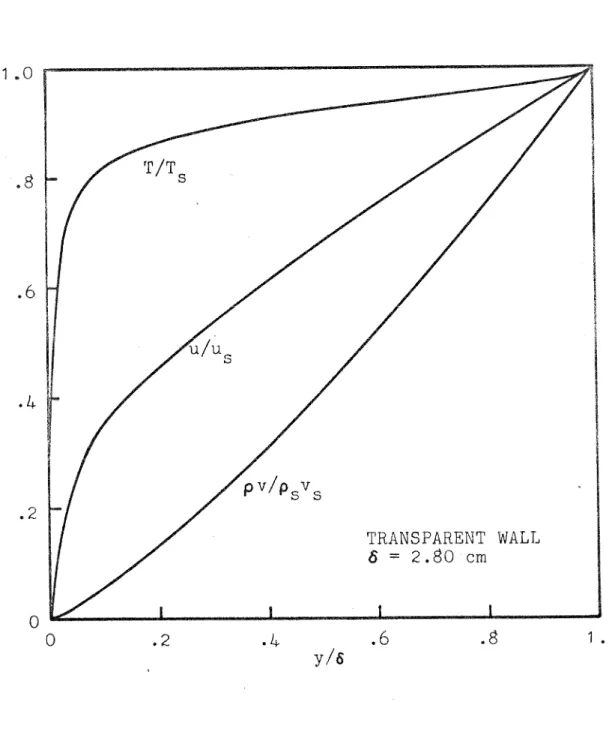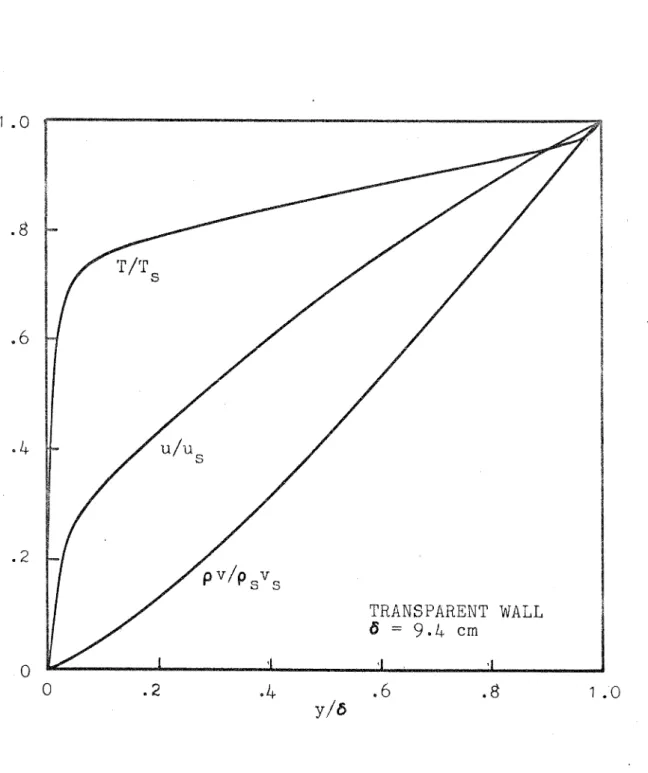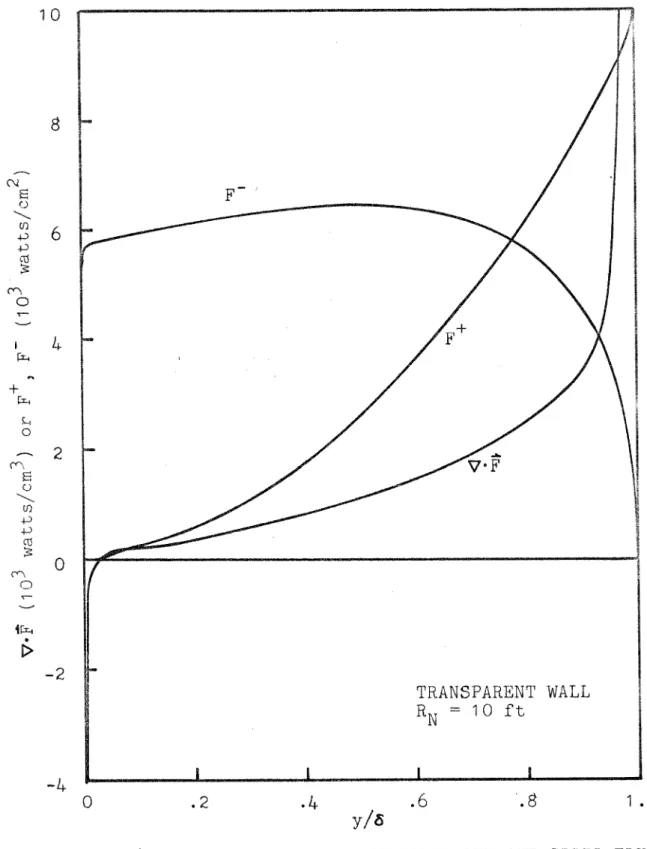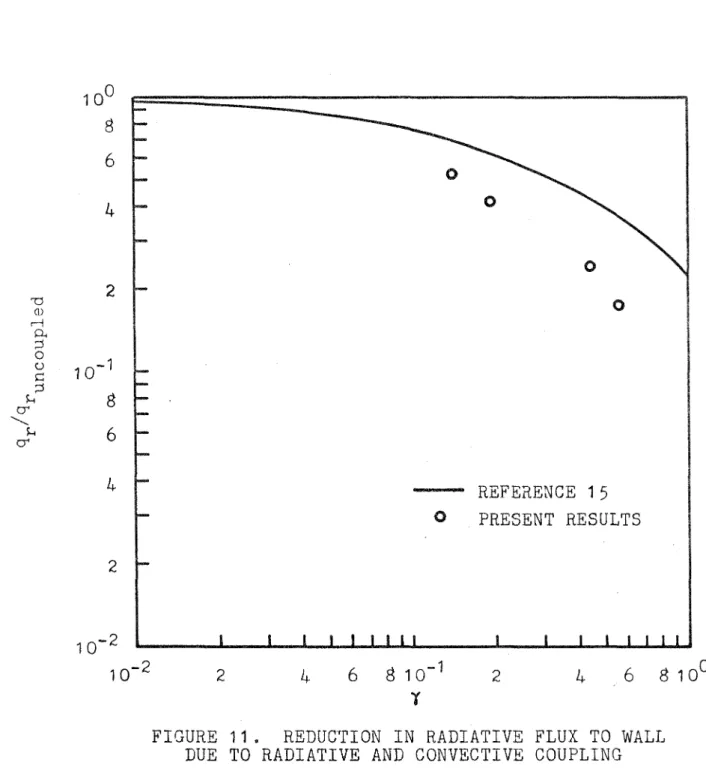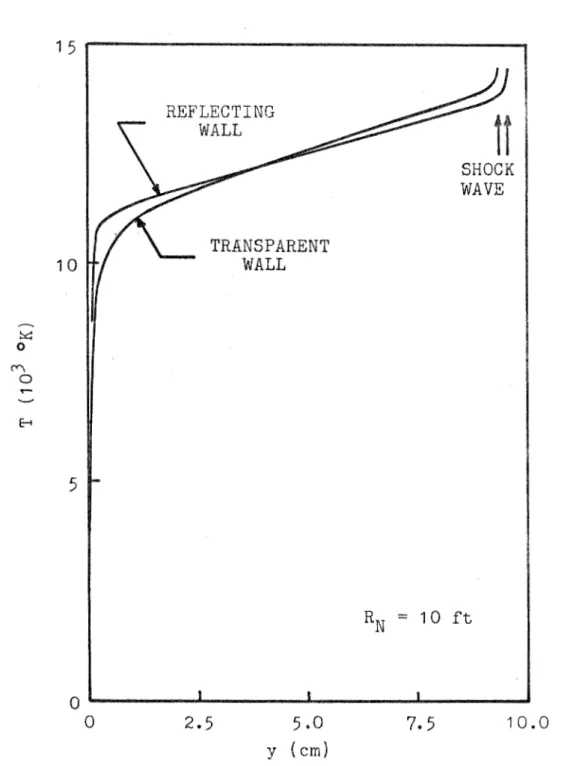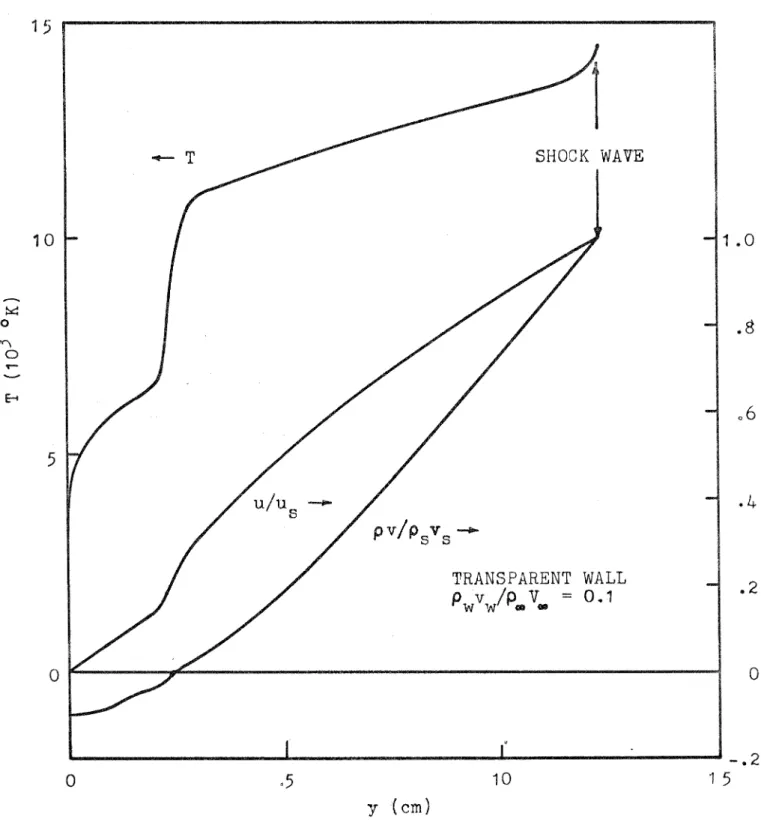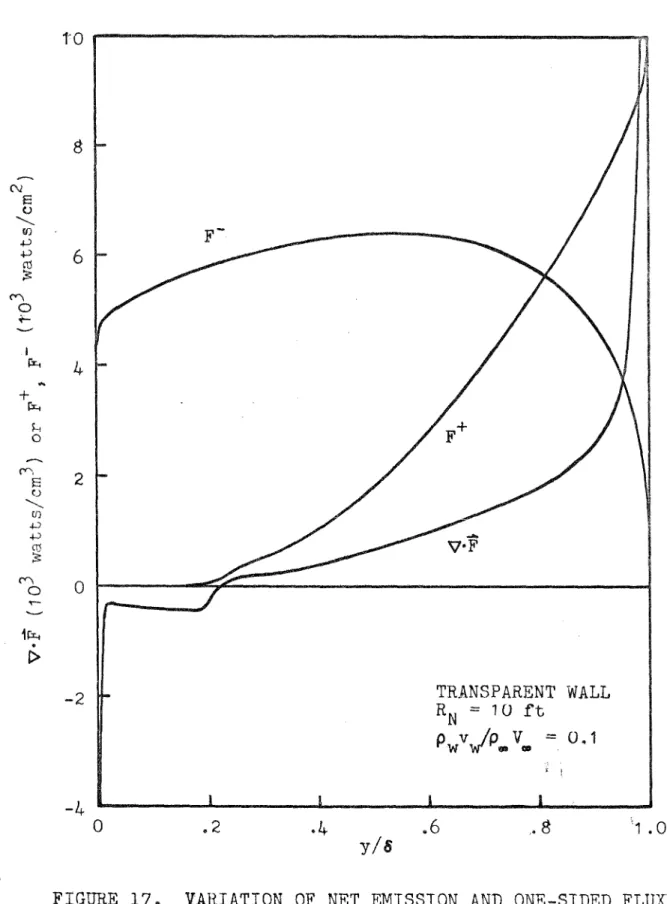In P a r t i a l F1dfiPlment of t h e Requirements Par t h e Degree of
Aeronautical Engineer
C a l i f o r n i a I n s t i % u t e o f Technology Pasadena, C a l i f o r n i a
June, 1968
The author expresses his appreciation to D r , Mi%eh Thonas, Dr, Bill Rigdon, and *ofessor Lester Lees for their enlightening
&seuasions and t h w ~ h t f u % . ~ o m e n t s which have had a significant influence on the development and scope of this paper,
This resemch WEIS sponsored by the NASA LaaagPey Reaemch
Center mder Contract go, Hug-7757 and by $he Douglas Aircrafk Company Independent Wesemch md Development Promm, e n t i t l e d
Wansf er (80301-010 39113 ) ,
At s u p e r o r b i t & reentry veboeities radiative heating is the dominmt mode of heat t r a n s f e r Lo the stagnation region of b l u n t reentry vehicles, The radiative heat transfer rate at the w a l l is detemined by the tenperatwe profile %hsrough t h e shock layer which depends on the net radiative $ransport through both %he d s e o u s inner region adjacen$ Lo the w a l l m d the outer region vhere eon~eetion and radiati-re trmsport processes dsniinate $he enera transfer, \$hen a%omsi.c line %ransitions are included a very small s c a l e 1enp"bh for radiant enerm t r m s ~ o r t is intraduced which r e s d t s in characteristic changes in the shock layer f l o w . The inclusion of atomic line transi- Lions necessitates eonsideration 09 self-absosagstion of radiant enera and results in the e o q l i n g sf radiant energr trmsport m d c o n ~ ~ e c t i o n a d eonduetion transport processes even f o r relatively s m d l vehicle nos e r a d f i
.
In the fomdation o f this problem no restrictions a r e placed on %he v a r i a t i o n of %he a b s o q " s i g coefficient ~f the m e d i u w i t h wavelength. 11s cn illustrative e x m p l e the e f f e c t s of nose r a f i m , w a l l refiectidty, and massive blowing have 'been coraputed for t h e shock Sayer f l o w f i e l d o f a s@erfed$y blunted vehicle a% 50,008 feet per second md 280,888 foot altitude in air,
Abstract
Table o f Contents
List sf Figures List O$ Symbols
TITLE
11. D i f f e r e n t i e l Equations: Application to the Pomssd Stagnakion Region of a S p h e r i c d I y Blunted Vehicle
I V mied Solutions f o r Atmospheric E n t q : Va = 50,000 f p s , h = 200,000 E%
References
Appendix A
-
Gas Properties Table %Figures
1 Coordina%e SysLen and Shock Layer Flow F i e l d ( schemati e )
2 Shock brer Flov F i e l d for 1 , 0 foot Eose Radius With go Blowing
3 Shack Layer Plow Field for 2,5 foot Nose Radius With No Blowing
4
Shock Laxer PIOW F i e l d for L O , O foot Nose Radius With No Blowing5 Shock Layer Flow F i e l d for 15,O f o o t Nose Radius WiLh No Blowing
6 Variation of NeL fiiasion and Owe-Sided F l u e s Across Shock Layer With No Blowing
FP I Spectral Wadiat i o n I n s i d e a ~ t Xiorma$ t o Wa11 f gar
1-0 foot Nose Radius With No Blowing
8 S p e c t r a l Radiria,%ion Incident Nsmal Lo 'Wall for 10,0 foot Nose Radius 'With No Blowing
9 In%egra%ed V * -+- F for Sbock-Layer Radia%fon Traveling
~ o w a r d t h e wall , o ) ~ a ~ u e t t e d
o
, U em from the$0 Heat W a n ~ f e r Rates &S a Function of Hose Radius With Ms Blowing
11 Reduction in Radiative Flux to ;t-Jall h e to Radia%ive and Csnvecti%be Coupling
12 Composition o f Badiative Heat FLUX at $he Wall as a fine$ion sf Hose Radius
13 Shock Layer Tmperatwe Bofiles Showing $he E f f e c t o f Wall R e f S e e t i v i t y
181 Uncoupled Flow F i e l d Solution f o r lOs0 foes$ Rose Radius W i t h Blowing
PAGE
23
24
2 5
26
27
28
29
30
31
32
33
3
4
3 5
1 5 Shock h y e r Flaw Field for 1 - 0 foot Hose Radius With Blowing
3-7
Varia%ion of Wet mission and One-$i&ed F l u e sAcross Shock Layer Wf%h Blowing
18 Spec$r& Contribdtion t o t h e Radf a t i s e Kea%
Wansfer Rate for 10,O foot Hose Eadius
19 Absorp&io~ Coefficient sf A i r a% %b, atm W e s a m e
and 1SfBQO"M
PAGE
37
spectral in%ensity o f black body specific he&
racik.ia%ive f l u vector
r&iative flux In posi$ive $-direction radiative f l a in negea-$ive p-direction alt f eUde
intensity of r a d i a t i o n total % h e m a eondue%ivity
Pinew spectral absorption c o e f f i c i e n t P1anck me= absorg%ion coefficient presswe
heat Lrwsfer sate a% m11
A dT/dy
distance from boar cenkerlina R e p o l d s Ember
b&g nose r d i u s
l i n e sf sight path lcngLh tmperatme
velsei%y pmallel Lo body veloci%y noma1 to body
freestre= velocity a o t ~ n e e n o r m 1 to bow
Y distance norm1 to body
T rsdiakion-convection coupling pmmeter
8 angle be%ween y mi% vector and l i n e of sight path LJ viscosity
P density
Q Stefan-Wltzmann constan%
w wve nmber
Subscripts
ta spectral
For atmospheric cn%ry veloei$fes above escape speed thema1 radiakion signifieanm%ly alters the flaw field about b1mt enLry bodies. The predominant effect of the radiance sf the hot gas eap is the d.n%ro&uetion of ent"na1py gradients in the outer shqck layer, Thus, when radiative transfer is important, the flow field can no.$ be sepwated i n t o the usual isoenergetir i n v i s e i d ou%er shoek lwer and a non-adiabatic viscous boundug layer, This effect has bean %rested by others using either the gray gas approximation"' or polynomial expres- sions for the velocity and eoncentration p r o f i l e s and n m a r i e a l ia%e- pation over &equeneg of radiation'2'. It is now well knom that use of the g a y gas approximtisn in radiative transfer c8leulations for high-taperaewe air results in serious error, Also the difficulties associated with inlegrati~ over frequency while also integrating .$;he
eonsemak ion equations are obvious ( ~ o s h i zaki and Wilson were limited to abou% 28 frequency p o i n t s ) .
As a rasul% of these difficulties
maw
approxba%e tecBBniques b v e been developed to solve rdiative gssmmic problens (319P+1961
In general the accmscy o f t h e vmious so1uLlons is u&n
f ligb% ewerbents have been made above 36,080 fps (EASA~ s WoJect PIRE) where couplianrp i s ra%;\zar weak, I n lieu o f e w e r b e n data f o r
shoek layer tempera%ures of approximate^ $5,00O0K and Pwge physical s%xe, more exact ce%.lcdakfons r a l s f n f n g complete spectral detail with as few flow field approxba%ions as possfble are required, I n pm%icu- lar atmfc l i n e e d s s i s n nust be included since, clue t o t h e very large
values of absorption coefficient at the center of these lenes, an e*remely ma11 scale lengkh for t h e radiant e n e r a transport is introduced,
I n j e c t i o n into %he b ~ u d a q layer is unavoidable i n t h e flight regime considered here since the heat transfer rates eweotm$ered
-
onthe order of 10 3 vatts/cm2
-
will necessitate either ablative heatshields o r transpiration esoXim for thermal protection, Pngection of foreign gas greatly eomplica&es the analysis proeedwe because $he absorption coefficient of %he gas-sir mixtwe, on which $he radiative transport processes critically depend, is a strong fuwc%isn of t h e
species present and %heir concentrations, However, the first order effects of injection on the sheek layer $ 1 field s%ruetme ~ can be dekemined by considering air as the injec$ed gas, and this approach will be used here,
In the present investigakion of these phenmena t h e p r h a ~ mphasis has been on r e t s f n i ~ as eomplete spectral d e k a i l as posefble, thereby m&ing f u l l use of existing knowledge of radiative mechanisms, The shock layer flow i s considered to be in local chemical and t h s m o -
ie equilbbrim f o r the entry conditions chosen, The e n e r a
equation is satis%fer% by using a n ftera%lve techiqua axid assming one- dbensisnality of the radiation field, Molecular heat conduction and viscous monaentw transpofi are retained across t h e en%ire shock layer,
The solutions sb-abained reveal $he de%ails of the shock layer flaw field s t r u c k w e and rdiakive transport processes as well as Lhe convective a d radiative heat transfer rates,
11. DIPFEWEliTIU EQUATIONG: APPEICATIBB TO TEE FORWmD STAGHATIOM REGION OF A
SPEmICGLY BLUmD VEHICLE
Consider t h e shoe% layer B 1 m field about the forward stagna- tion point of 8 blunt body shorn schematically in Figwe 1, In order Lo =count f o r radiative t r a n s p o r t of enerm %he edfre shock layer m w t be considered,
For ~ - 8 a a a ~ - s t a t e , axismetric flaw $ha t h i n shock layer equations are the following (1)
60ntfnuity
asg
a
ul a a~
++
pvc--
= u22
+ P ( ~ ) ++
(rlt---I - v
e FPuep
I G
P 3~ ax 33-where -+ F is t h e radiative flux vec$or, The coupling be%;ween the radia-
t i v e enerw %rawsport and t h e okher processes is evidenced by the inclusion of $he net radiative energy loss per unit v o l w a , V * -+ F , in
t h e energy equation, The evaluation of this t e r m is considered in Seetion 111,
These aquakisns can be reduced t o ordinary d i f f e r e n t i a l
equatisns valid near the stagnation s%remPine by noting tb&L t o firs%
order in x
The continuity equakion then becomes
S u b s t i t u t i n g Eq,
5
in the momentm and snerm e q a t i o n aria neglecting terms of order x yields the f o l l m i n g :Msmen%m and Con%inui%y
T d
p
-
"""-
d"%P
w
d~( A , , - * f
(7)where, after Referenee 1, %p/ax, has been replaced by its value i m e d i - a t e l y behind a spherical shock nem the sLagnatisn s t r e m l i n e ,
The boundmy conditions on Eqs
.
6 and -re at y -. ODV "" PWVW
1 a(ov)
m - s
P
Qf
" "
TWwhere 6, the shock s$md-off d i s t m e e , i s t o be deternine& e o m t h e solu%ion,
For cases i n which blowing i s absan% i n t a p a % i o e of E q s , 6 and 7 i s started at t h e d l by assming values f o r $he convsc-$;fve heat trwsfer rate an& shew stress and continues away from t h e wall
~ % i l %be shock ( Q V - - O P m ~ w ) i s ~ e a c k l e a ~ "6"8b~lkl.$. V ~ ~ $ U B B %he B B ~ % m f e s i o n as a f m e t i o n o f p v a r e uses i n t h e s o l u t i o n of t h e enerm equa%ion to obtain soku%ion C W V ~ B f o r the tempera%me. Boundary eon- d i t i o n s on T and -a at the shock are matches by repea%ed adgustment of
$he esnvec"$ivs heat transfer rats and shew at "$e wall,
m e n mssive blowing i s considered some modificstfon t o this procadme is required, I n % e g r d s01utions 0-2 both t h e rnmanem and e n e r a equations can be e a s i l y obtainede For i n s t a n c e , t h e solukion of the e n e r a aquation i s
where
This equation shows %hat small errors in %he ehsfea of ~ ( o ) cause the computed v d u e of ~ ( y ) t o depmt e w o n e n t i a l y from the correct v d u e of
&(y) I n regions where p v is greater than zero, Since pvc /A is of the P
order o f P Lo 1 0 for the case considered here, the error grows very fast. The situation i a m a c t l y %he a m @ when %he momsntu equation is considered, In general the requirment that both o f these equations be in%egrated simUtaneous1y means %ha% v s y i n g initial v&ues of $ha convective he& transfer rate and t h e she= streso a$ the wall is not a practical way t o satis* boundmy conditions imposed 8% %be shock, I n order to overcone this difficulty, nmerical integra%ion fs started at pv = 0 (i,e,, away from the w a l l ) and proceeds in both d i r e c t i o n s , m i l e this procedwe eibhinakes the n m e r i c a l integra%ion instability i n the b;lbom region, it r e q d r e s that fom i n i t i a l V ~ U C S be f%era%ed upon ( ~ ( p v =
o ) ,
u ( p v = 01, d ~ / d y ( p v = 0 ) and the shew stress at pv = 0 ) and $ha% %he boundaq conditions on T and u be m&ched at both t h e w d l and the shock, The addition of two more initial values quad-- r u p l e ~ the complexity of the i t e r a t i o n procedwe required since there a r e now s i d e e n deriva%ives sf the end v d u e s i n s t e a of fom as when integration is s t a r l e d a% the w a l l ,In order to evduake the net raaiant energy emission, B * + P ,
the s c t u d shock layer g e m e t v is replacad by a plane pwalPe1 layer, i n f i n i t e in extent, w i t h properties vmying only in t h e y-arection, The net emission from this layer is then given by
where F denotes the f l u of r&iant enera in the y-afrection, This approxiaatien is in accord with the resvlts of who computed t h e f l u x in the x-direction employing the gray gas assaption but not the plane pwallel shoek
lwer
approxhatfon, E i s reaul$s indfca$e that %he contssibu%ion $0 V * + P f i g s a n t h e x-dirsctfon flux 2s smll, B eplane pmalLel shock layer approx-tion is mare valid when a$omic l i n e s and d t r ~ v i o l e t photsionizatfon eontinurn are include8 since t h a t p& of %he radiation s p e ~ % r m behaves i s % . an opaque mmner (except new the bomdmlss) and o d g radiation from newby poin%s is hportane, Splitting the flux into p o s i t i v e and negea;$ive y-cmponen%a reslnlts i n
F(Y
1
= ~'(y)-
~ - ( y ) ( 91
In Eq, 10 8 is $ha angle between a line sf sight pa%k fron the edge sf the Payer to the y-sta%ion an& the y-seetor along t h e stagnation s t ~ e ~ l i n e (see Figme 1). I is the specLsa1 i n t e n s i t y of r a & % a l i o n at
@
y t r a v e l i n g i n the 8 d i r e c t i o n and is given by integration of t h e Wbert-Bouguer l a w for a nsn-scattering medim
where a denotes distance slow the l i n e o f sight path,
The bomdav conditions on Eq, 11 depend on the optical proper- ties sf the m P 1 , T h e e E i m P t i w w d 1 conditions are considered hers, The usual condition b p o s e d is $ha% %be mB1 is perfectly transpwent.
This b p L i e s t h a t
I ~ ( o , B ) = 0 f o r all w and 0 '8 5 n / 2 (l2a>
The o%her two limiting eases a r e a perfectu black w a l l o r a perfectly reflecting w a l l . The radiative b o r n d a y conditions f o r these two eases w e as f 0110~s ;;:
black wall
l o ( 0 , 8 ) = B ~ ( T ~ ) f o r all w and O 2 8 c n / 2
ref l e e t i n g w a l l
I ( 0 , 8 ) = 1 ~ ( 0 , n - 6 ) f o r a l l w a n d 0 f3 312
W
- -
(3-2e1
Eqs, P2a, b, e set t h e i n i t i a l conditions f o r t h e intensity of radiation leaving t h e wall. The bomdasy csndi%fons for the radiation t r a v e l i n g Loward the w d b are usually set by t h e conditions of a trans- pmen% shock and no mission from the breestrem &he& of t h e shock.
Bowever, it should be recognized that some Braetion of %ha r a d i a t i o n
L h s b leaves the shock Payer will be absorbed by the freestrem thus raising its temperatme and increasing i t s emission, A quantitative esLima%e sf this effect has y e t to be made and the a s s m p l i o n of no emission from the F r e e s t p e a .%rill be re%ained for hi^ investigation.
The boundary condition for the radiation traveling toward t h e wall i s Lhus
I ~ ( S , B ) = 0 f o r all o and r / 2 8 - c n
.
(13)These equations permit t h e evduation sf the net emission from an elmental unit volme of gas, provided the temperature profile is
hewn, Since the temperature depends on the value of the net emission, which i n t u n depends on $he %emperra$ure profile across the entire shock layer, an iterative technique is mployed in this invesliga%ion, Assmad tabular vdues of the net m i s s i o n as the fiiammction of p v are used in the solution of the conservakion equations $0 obtain solution cmves for the t a p e r h u e . The first set of these v d u e a i s obtained 'by empuking
B + F $OF t h e -coupled kemperature profile, i,e,, t h e solution of the conserva%ion equations wi%h V + P f 0 , With the temperature profile
computed, E q s ,
8,
9 , 1 0 , and 11 are used with the appropriate boundmy conditions a% $he w i p l l to c o m p t e new values for %he net emission, Eq. 11 is solved using second-order Rugge-Ku%$a for the most p&,However, d e n %he Intensity at any frequency becmes close to the black- body value, the s s p p t o t i c form of Eq, 11
is used, The use of this ~ s ~ p t o t i ~ egression for the intensity allows l u g e integration intervals to be used, tmically about 1/100th the shock layer thicitness, rather than intervals of the order l / k o
required P s r integration stability if t h e f u l l equa%ion were retained, The intensity for eight different s%a& d i r e c t i o n s $bough t h e Payer is found by integration along each path; f l u e s are t h e n delemined by Gaussim quadratwe. This cycle is repeated u n t i l t h e input and output net emission curves converge,
EV, TYPICAL SOLUTION6 FOR ATMOSPHmIG Y Vm = 50,000 i p s , h
--
200,000 ftme method8 described in Sec"$Ions II and III have been used t o obtain sslu%fons for atmospheric e a Q q at 50,000 f e e t per second and
200,000 feet altitude with a m11 $emperatwe o f 2000°K, The air prop- erties used are described in the Appendix, $aPsnspod of r d i a n t energy by a%omic l i n e transitions i a included, In the following discussion sf the resdLs obtained pmtfcular atten$ioir% is paid t e a the effect of the inclusion of a%omie line radla%ion,
Flow F i e l d Solutions
The effec$s of radiwt enerm transpork on the shock 1ayer stmctme f o r mrious nose rdif and a tranapmant w d 2 are shorn in F i w e s 2, 3 , h-, and 4 , b i s s f s n of t h e m d radiation results in s eoa%-$inuak deerewe i n temperaewe as the gas B l o w s towwd the wall,
ma
sharp decline i n temperatme near $he shock i s due to the b d l d up of intensity in the vacum a L r a v i s l a t speekrm to the black bow limit, T h i s oecms a v e q s d l distance behind t h e shock wave due to the lmge v a u e s of the ku for t h e atomic l i n e s . The lmrr tempcaratma throughout the shock Payer r e s d t s in higher density and a earresponding deereasein %he shock s$and-off distance, Shear s%ress a% the WE&% i s increased and t h e velo~itg b o m d a q layer thickness decreased due to the coupling of radia%ion and cog%vec%ion enerm transport modes,
m e r a i a n t e n e r a trwsport Is shorn i n Figme
4
f o r a 10 foot nose radius, The net emission at the shock is only slfghtLy lwgea thanthe Lranspwent emission into 271 steradians, i , e , , 2
kp
( T s ) aTs'.
A s t h e f l u travebiw toxwd the wall, F-
i" builds up, the net emission f a l l s r a p i u g due %s self absorption, The efiremely large value of V * + F at%he shock (about 250,000 waLts/cm 3 ) produces t h e steep declines in tem-
perature at the shock wave evidenced in t h e flow field aolu%isns, Since the temperatwe decreases con%inuoualy as t h e gas flows toward the bo43-, F- does not increwe monolsnieally w i t h increasing distance from the shock* The absorption spike close Lo t h e wall is due entirely to ab- sorption of t h e F- flux in the boundary barer, Because of the small L h i c h e s s sf the bomdary layer, however, the reduetion of t h e radiative heat transfer rate at the w a l l is sml%, For large nose radii the eon- version of r d i a t i v e to eonveetive enerw in the boundary Sayer has a
significant effect on $he ssnveetive heat Lransfer r a k e ,
Figmes 7 and 8 present the spectral radiakion incident- normal to the w a l l for nose radii of" 1 and 1 6 feet, respectively, The centers of" the vbeum ultraviolet lines are seen to be strongly self-absorbed while the wings contrfbute s i g n f f i c a n t u to %he flux at t h e w a l l , The
infrared and visible lines, t h w g h no% self-reversed, w e somewhat self-absorbed at the lmger nose radius,
Figme 9 shows %he contribution to t h e net emission from %he flux in the negaLive ;y-direction at a position O , 1 1 c m f r m the w a l l for
$he PO foot nose radius, A t %his position the a a l m i i e Pines have already been self-reversed and the dominmt mode of radiant energy t r a n s p o r t is d t r a v i o l e L merged-Sine and photoionization continurn absorption,
Heat Wansfer Rates
The dependence of the radiative and convective hea%ing rakes on nose radius wikhout b l m f n g i s ahom in F i g w e 10, The dashed lines indicate the ucoupled heating rates, obtained by ignoring the radiation tern In the enerw equation. There are two conpensating e f f e c t s tending to pertmb the convective heat transfer rate; the reduced enthalpy
po%entid due Lo radiazive cooling tends to decrease $he convective heaking rate, while radiant anera absorption in the boundary layer tends to increase it, m e n atmic lines are eonsidereel t h e latter
effect domf nates except at small nose r&ii where boundary layer abserp- t i o n i s smll. Eowever, if atomic line radiation is neglcctedthaae
effects tend to cancel as shorn i n Referenee 2 ,
As discussed pre?f~iously, t h e radiative flux a% the wall i s
reduced due to radiative cooling, shock layer absorption, and b o u n d a ~ l ~ a r absorption; boaaaadmy layer absorption i s relatively unimportant except when large blowing rates are considered, These mechanisms pro- vide subs$antial reductions i n the radiative flux to the s w f a e e ss
shorn in F i g w e $1, Were the reduction in radiative heat transfer rate
i s correla%ed with .g, t h e ratio of total weoup%ed energy l o s s
$0 the to%a41 available freestrem enerm, The inclusion of atmic lines is seen to enhance the reduction in radiative heating t b o u g h the mechanism o f increased tempera%ura drop -edfa%ew behind the shock
of the heat transfer rates obtained for all cases in- vestigated is given in Table 1,
A s s h w n in Figwe 10 the rebeliative heat transfer does no% in- crease mono$oniealFky with increasing nose r d i u s , Radiative heating is
m a x i m w for apprsxhate1y an II foot nose radius at the f l i g h t eondi-
% i o n s eonsidered here, Figme 12 shows t h a t t h i s r e s u l t is due $0 a deerease I n the F l u from %he strong lines and ul%raviolet portion sf
r e a c h i n g t h e wall. This e f f e c t can be $raced to t h e lower tmperatwe at %he edge of the boundary Payer with increasing radius due to s a d i a t b e cooling,
The influence of wall reflectivity is shorn in F i g w e 13, The kernperatwe profile for %he PO foot nose radius shock lqyer w i t h a totally r e f l e c t i n g wall (wall is p e r f e c t l y r e f l e c t i n g at all wave lengths) is compared to %ha% of a traospment wall, The to%all'y ra- fleeting wall is $%%a limit ease and ilPus%ra%es the m u h m e f f e c t due to wall reflectivity, The erithalpy potential across the boundary layer
i s increased due Lo absorption of $he r e f l e e t e d f1m and t h e eenveetlve heat LransEer r a t e i s increased, Since a u o s t half of the radiant enerm ineiden* on the w a l l i s v a e u ~ - u ~ % r ~ v i o P e t 3 for whieh all materi- a l s are n e w l y black, the Lotally reflecting xa91 does no% represent any r e d s u ~ f a c e . O f more practical concern is %he affect of totally
black walls, Calculation of the net r a d i a n t emission a s s m i n g a t o t a l l y black w a l l results i n values iaenticaab ( x i t h i n the accuracy sf t h e ca$- culations) Lo those obtained for tranepwent walls, T h i s r e s u l t i s not s w p r i s i n g since the radiative P 1 n emikted f r o m t h e cold -wall i s much less khan %he f l u x from the high temperature shock l a y e r , 1% can be concluded $hen t h a t %he raBia%ive boundary conclitions a t t h e wall have a negligible e f f e e L on the gas cap radia%ive transfer and the t r a n s p a - ent wall a s s u p t i o n is sufficient for eonputing the flow field s o l u t i o n ,
Strong blming sslutisns are especially important 8% high entry velscities because radiative heating will induce massive ablation sf the vehiele surface, Thus, it is imperative to understand %he affects of
l a r g e blmiw rates on the shock layer flow field strucLure and the attendant changes fn radiative and eonveetive hea% transfer rates, I d e d l y , of eowse, one w o a d Like to csrm out this investigation using radiative and transporx properties for %he blown gas nixture which correspond to the complex molecu%ea present in the a b l a t i o n proaucts of most %beat s h i e l d material,
The blowing rate used in %he present study corresponds Lo wha%
would be a classical shear 1 w e r ( p v
W W 9-Vm >> 1) solu%ion if raaia%ive coupling were neglected, T h i s is ilPus"h;r%ed f n P i g w e
14
which shows the temperature and tangential velocity profiles obtained by integrating the conservation squations with V + F s e t to zero, The
region Prom the wall Lo a'oou% y = 0 0 , 9 em has t h e properties of constant non-zero shear (as also f m n d in Reference
7 )
and temperawre; %he region of maBm shear is displaced from the wall by the s m e mount,sen
r a a a n t enerw $ransport is included strong reabsorption by tihe cooler i n j e c t a d gas r e s d t s in the flow fields shorn inF i w e s 15 and 16 f o r 1 foot and LO foot nose r a d i i , respectively, For the 90 foot case eonveclive heat transfer is increased from zero
(fox- the uncouple& profile) $0 135 wa%ts/cm and 2 the radiative heating reauced about ~ 8 % to k322 w&t%s/cm 2
.
If the b l o m gas were emposed of abla%ion products including complex molecules which have sus%an%fallybmger absorption coefficients t h a n air, the conversion of radiative $0
convective e n e r u would be enhanced and %he radiative h e a t i n g f w t h e r reduced ,
The radiative energy t r a n s p o r t f o r this case i s s%ao~m in
P i g m e 17, It is seen that there is a n e t absorption s f r a d i a n t enerm through the injected gas r e g i o n causing F- to decrease significantly from its maximw value at y/6 approximately equal %o one-half, A corn- pmison sf t h e integral sf the f l u inefden% on t h e wall as s fmction of w
f o r %he blowing and no-blowing ten-boot nose radius eases is shobrn i n F i g w e
18,
It is evident from these curves $hat the reduckion in t h e r a d i a t i v e heat transfer to the w a x 1 for the blowing case is due toabsorption o f radia%isn in t h e merged ultraviolet lines and photoioniza- tion eoai%$inum by the b l m n gas,
Toe stagnation-pain% shock-%eyer equations have been solved using detailed s p e e t r d caleula%isn s f t h e r d i a t i v e - c o n v e c t i v e
soupling. Atonic lines are included in t h e description of t h e absorp- tion c o e f f i c i e n t and their spectrd structure i s retained twoughout
%he c a l e d a t i o n prscedme, The so1utions obtained indieate Lh& the inclusion of atomic lines efianees t h e rarsbiative cooling effect
resulting in decreased radiative flux a t the w a l l , Hmever, s l i g h % l y 5ncreased absorption in the bomdary Payer causes t h e convective he&%
transfer ra%es to increase above the nomind value that qmuld be obtained if radiant e n e r a ZransporL were neglected,
The solutions obtained w i t h strong blowing indieate %ha$ r a d i - an% enerm transport can s&rongly modify t h e flow f i e l d strue%we 191
"$he b%okm gas region through absorption in the ul%saviole% p o r t i o n o f
the speetrm, S i g n i f i c a n t reductions in &he r a d i a t i v e heat transfer ra%e ocew due t o t h i s absorption,
me affect of r s d f d i v e boundary cond%tlon~ a$ the &;pa11 on
shock $apes sdructme wss considered and f m n d to be s m d l f o r rara_bistic e n t q body properties,
Bowe, J, T, and Viegas, J, R e , a'601utisne of the Ionized Radia%ing Shoe$ hyerg Ineluding Reabsorption and Foreign Species EfPec$s, and Stagna%ion Region Hea% Transfer
MA
TRR-159 (1963) .
Roshiz&aL, H e and Wilson, K, H e , gJCog%aivective and Radiakfve Heat e a n s f a r Dming Superorbital Entry, ' ' A I M J ,
,
V o 15,
25-35(1967)
,Anderson, J r , , J, D,, "'Bsn-gray Radiative Wansfar Effects on the Rsdia%fw SeagnaGion Region Shock b y e r and Etagnation Point Heat Wansfar
,"
NOLYE67-104 (1967) .
Chapman, G , T , , "Heat eansfer in the 8tagna%ion-Point Eminar Ssmdary Layer with Mass Transfer and Radiant Enerm Kosorp%ion
1 )
Dirling
,
Jr ,,
R B., Rf gdon, $9. S,
and Thomas q, M a Sd$wnatiog%- Point Heating Ineluding S p e c t r a l Radiative ~ r a n s f e r , "-
B~rdedSngs of the1967
Beak %ansfer and Fluid Mechanics Institu%e, StanfordChang
,
P, and Id, G , Vineen%i, '"nvf s ~ i d Radiating Flow Wer a Blunt Body ,I' Report SWMR No, 278, S t s n f erd, Calif,,
Stanford University (19461
KubsLa, T,, and Pernandez, F , L , , " " ~ m d a r y - ~ a y e r Flows with Large Injec%iorsa and Heat T r a n s f e r
,"
A A $ U J ,,
Vol , 6, 22-28(19681,
Thomas, M e , 9?Phe Spectral Linear Absorption Coefficients o f
Gases--Computer e o g r m SPECS (~189),'"epor% DAC-59135,
Saw%a k*lonica, California
,
Douglas AircraBL Coapany, Inc , ($966 1
,Wbese, W, L ,
,
Smith, M e W,,
and Glennon, B e M a , "A%omic Wansition Probabilities," Vol, I, Eybogen Twough Neon, Rational Bmeau ofS%a~"edwds, MSmS-IqBS
4 (19661,
Griem, H , R e , MeGsaw-HI11 Book Co,
,
New York (1964 1,
st ma^, 9, 6,
,
and Pyej-tt, K , D,,
Jr ) 1 P ~ h e o r e $ i ~ 8 b Study of Optical B o p c r l i e s-
Photon Absorption Coefficients, Bpaci%ies, and Equa%ions of State sf Light EElemen$s, Including the Effect o fLf nes
, "
Report GA-2528, V o l eI Q
WS'B"/-TR-~~-~P V o L , I1 ,
General Atomic Division, General wnmics Corporation (99911,Martinez, M a R e , "Descriptioa of Computer Proarm B187
-
Themochemieal E q u i l i b r i m Bcsperties of Mul%icrnponent Systemsb and Hz89
-
Sta%istieal Themodynmie Prope&ies sf Single Gas Gpeef as ,'"AC-59133, Santa Monica, California, Douglas A i r c r a f t Compaqv, IDC,,
( 19671.
13. Cruise, D, R,, "Notes on the Rapid Cora.pu%atisn of Chemical E q u i l f b r i m
,*' -
68, 3799-3802(1964) .
1 4 Wigdon, W, S,, "'A Computer Code f o r Calculation of Wansport
*opert ies o f High-Temperatwe Gases DAC-$9134 ) Santa Monica $l
California
,
Douglas Aircraft Co , ( in prepmat i o n ) ,15. Gruszezynski, J , S, and Warren, J r , , W, R e , "Study s f E q u i l i b r i m A i r T o t a l Radiation ,'QaIM J B ) Vole
5,
517-525(1967).
Appendix A GAS PROPmTEES
The s p e c t r d line= absorption eoefficienk i s of eri$ieal
&porLanee for accmate calculations of the radiadive heat transfer to (8
1
e n t q vehicles. The values use& in this study a r e those of Thomas In that work a complete description of the spectsd absorption coeffi- cient was made including band radiation, photodissociation, photoioniza- tios, photodetacbent
,
atomic lines, and brebsstrahlung Atomic l i n e s belongiw to md%iplsts were grouped together, since for tnicsab ra-entry con&itiona he found the spacing be$;ween lines of a particulm multfplet "$ be usually of the s m e order as the line half widths. The f-numbers f o r the ultraviolet lines were taken from NBs'~' and for the visible lines *om ~riem'"). Thomas used the hydrogenie model of
Steward and matt to define lines close to the photoelectric edges.
9 4=
Lines from E, N
,
0 , and 0 are included,Thomas has generaged the spectral l i n e m absorption coefficient for air at approximg%%ely 2000 spectral points for Le~peratwes from 2080°K %Po 6 0 ~ ( 3 0 0 ~ ~ and pressme% from 0,603 to 300 atmospheres, The values used in the preseaa$ investigation were sealed aceording to pressme from the values calcdated at P atmosphere, P i g m e $9 shows the values of Bw Thomas obtained st 1 5 , 0 0 0 ° ~ and 1 atmosphere pressure.
The themodynmic properties of air used here are those obtained by Martinez"" from solution aE the chemical equilibrium
(13) equations bg. the method of Cruise
The t r a n s p o r l properties were eslcaa%ed by the method described f n R e f erenee
14
at the a c t u a l stagnation pressure ( 8.&6
atmospheresE q u i l i b r i m eoneentrations of 18 air species were used and t h e effects of charge exchange encounters were considered, The viaeosiLy and
c q u i l i b s i m thermal conductivity were ealeula%ed $0 the second+riEer including the effects sf' LhermP diffusion,
SUltfi4bB:WY OF CASES STCiDIED V
-
50,000 f t / s e e h = 298,OOC) ft03
Ty = 2000°1:
10,O Black C 600 5296 5896
-
..2. Mulurl?crs i n parenthesis refer' t a antrcou?_icc" h6a-k tr .::sfe~
rwtes
.
FIGURE 1 .
COORDINATE SYSTEM AND
SHOCKLAYER FLOW FIELD
(SCHEMATIC
)FIGURE 2. S H O C K LAYER
FLOW FIELD FOR 1.0 FOOT NOSE RADIUS
WITH
NO BLOWING
FIGURE 3. SHOCK LAYER FLOW FIELD FOR
2.5FOOT NOSE RADIUS
WITH NO BLOWING
FIGURE
4 . SHOCK
LAYER FLOW F I E L D FOR 1 0 . 0 FOOTNOSE
RADI3S WITHNO
BLOWINGT R A N S P A R E N T
WALL
S =
1 3 . 8 5
cmF I G U R Z
5 *
SHOCK LAYER FLOW F I E L D F O R 1 5 . 0FOOT
N O S E R A D I ' J S W I T H NO BLOWINGFIGURE 6. VARIATION OF NET EMISSION AND ONE-SIDED FLUXES
ACROSS
SEOCKLAYER WITH NO BLOWING
I
E 0
'XI -2 0
;= W Z 6 3 - H H
L) 2
Hcn 23
=r,
F I X R E
9.
INTEGRATEDv*F
FOR SI-IOCK-LAYER RADIATION TRAVXLING TOWARD THE WALL, EVALUATED 0.11 CMFROM
THE WALLI
o5
8 6 4
2
I
04 8
h
0 1
6
E 0
\ rn
+-,
4
+.'
1%
-
5@
2
I
03 8 6
4
2
TRANSPARENT
WALL1
02
0
5
10 1 5R N ( f t )
F I G U R E 1 0 . H E A T T R A N S F E R R A T E S A S A F U N C T I O N OF
NOSE
R A D I U SWIT2 NO BLOWING
FIGURE
1 1 .REDUCTION IN RADIATIVE FLUX TO WALL
DUE TO RADIATIVE AND CONVECTIVE COUPLING
FIGURE 1
3 .
SHOCK LAYER TEMPERATURE PROFILES SHOWING THE EFFECT OF WALL REFLECTIVITYFIGUHE 1
4,
UNCOUPLED FLOWFI&LU
SOLUrI'IOM F O R 1 0 . 0 F O O T NOSE R A D I U S WITH BLOWINGF I G U R E 1 5 , SHOCK
LAYER
FLOW FIELD F O R 1 . 0 F O O T NOSE R A D I U SWITH BLOWING
FIGURE 16. SHOCK
L A n K FLOW FIELD FOK 10.0FOOT
NOSE RADIUS WITH BLOWING
TRANSPARENT WALL
FIGURE
17,
V A R I A T I O N O F N E T E M I S S I O N AND O N E - S I D E DFLUXES
A C R O S S SHOCK LAYER W I T H BLOWING
